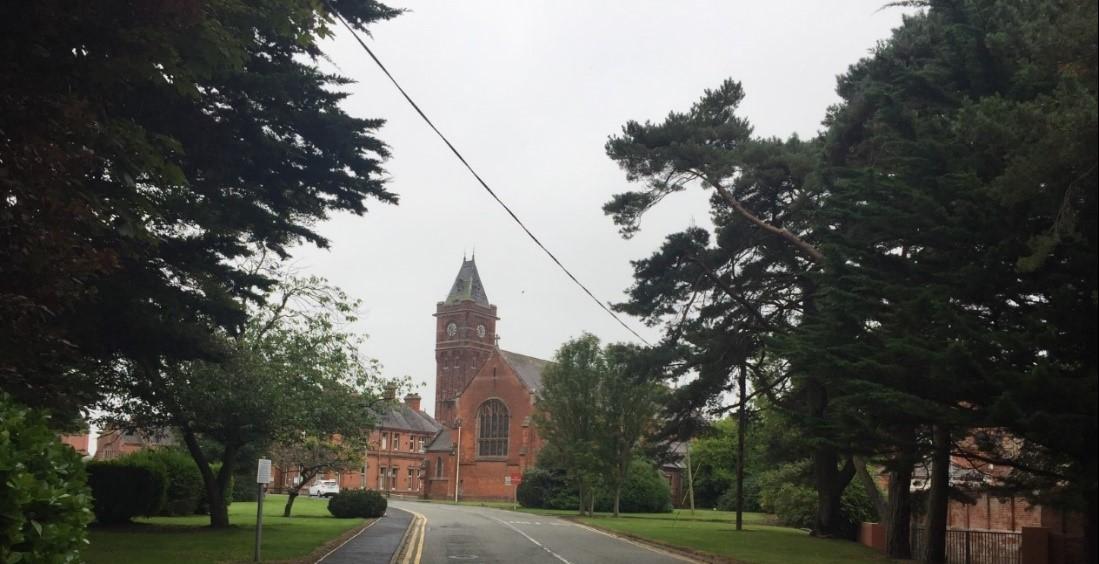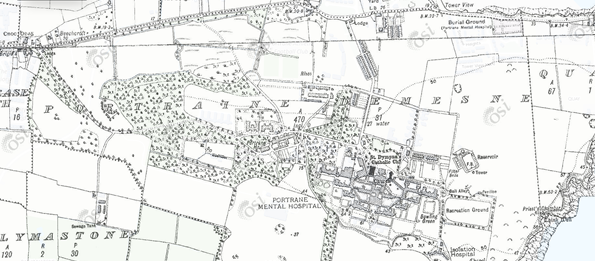Portrane Demesne: Cows, Continuity and Change

The Portrane peninsula is now synonymous with the gothic red brick buildings of St. Ita’s but before the hospital stood on these lands, they formed part of Portrane Demesne. Our earliest records concerning the lands comprising the demesne shows them being granted to the Church of the Holy Trinity by King Sitric of Dublin (King Moylan 1960: 25). Later records show the lands being leased to an Eyre Evans in 1728 and it was the Evans family who developed both the woodlands and the stately manor known as Portrane House within the demesne. Although the house no longer stands today an advertisement from the 1800s selling the property describes it as sitting in an elevated position ‘’commanding magnificent views seawards of Lambay Island, Ireland's Eye, Howth and the Bay of Dublin, and the coast and mountains to Bray Head’ (Courtney & Goucher 2007: 14). The same advertisement describes the property having a basement, billiard room, library, conservatory, stables, herd’s houses, gamekeeper’s cottage as well as lands comprising of 470 acres. Despite the expiration of their lease the Evans family must have felt very connected to Portrane as their tombs can be found in the ruins of St. Catherine’s Church just north of the estate boundary.
In 1893 the house and land were sold to the Board of Control for the Erection of Lunatic Asylums for a sum of £10,000 (King Moylan 1960: 27). The Board had sought to acquire these lands as they were removed from the mainland offering peace and quiet for the potential patients. Gothic revival architect George Coppinger Ashlin was engaged to design the hospital and construction began in 1896. The distinctive red brick used to construct the hospital was purchased locally from the Portmarnock Brick Company. The most striking feature of the construction is the clock tower 9pictured above) which held a massive water tank for use in the case of fires. The hospital complex which was constructed to house 1,200 patients grew when it acquired Ballymastone farm and a portion of the Turvey estate (Bates 2001: 171). This allowed the hospital to farm its own produce and keep a herd of about 300 Frisian cows who up until the 1960s roamed around Ballymastone farm and Turvey Avenue (Ryan 2019: 11). The following is a local memory of the farm:
The grounds surrounding the hospital are very extensive and beautifully kept. They include a Sports field, huge garden and farmyard, with a large amount of pasturage. It is practically self-supporting, grows vegetables, crops, kills its own meat, while its milk from a special herd of cows is famous.
(SC Vol. 0789: 334).

The hospital still stands today as a landmark complex of red brick buildings which the HSE has updated into a new state-of-the-art facility for the provision of modern psychiatric health care. However, the development its buildings and grounds caused great changes to the landscape of Portrane Demesne. The woodland planted by the Evans family was cleared to use as fuel while areas of wetland were drained to allow for the cultivation of crops. One of these wetland areas which lies just north of St. Ita’s campus is currently being managed by Fingal County Council to pilot a new biodiversity scheme which aims to rewet the site. It is intended to function as a piece of green infrastructure catching the runoff surface water from the adjacent St. Ita’s campus. The work being done for this project was recently showcased to the public as part of Dublin Climate Action Week 2021. An onsite visit allowing members of the public to experience the wetland was hosted by Hans Visser the biodiversity officer for Fingal County Council. The visit allowed a closer look at the highland cattle (under the watchful supervision of the farmer!) who graze the site. The cattle were selected to graze here as they are smaller and lighter than other breeds enabling them to roam around without sinking into the waterlogged clay. Allowing them to graze clears away larger vegetation ensuring smaller plants can gain a foothold which in turn increases the diversity of flora and insects on the site. The cattle are herded by Glenasmole farm, a family run business who specialise in rare breeds and free-range, low-density biodiversity grazing and rural farming methods. The partnership between Glenasmole Farm, Fingal County Council and St. Ita’s is allowing this site to continue as a working farm while becoming a rich habitat for a range of species and a much-needed piece of green infrastructure for the area.
Want to Delve Deeper?
If you want to learn more about the biodiversity projects happening in Fingal, check out http://www.fingalbiodiversity.ie. If you want to know about the rich architectural heritage of Fingal have a look at www.buildingsofireland.ie. If you want to follow the movements of Fingal’s highland cattle check out the Glenasmole Farm Facebook page here.
- Aoife Walshe
Bibliography
Bates, Peadar (2001), Donabate & Portrane: A History, Dublin.
King Moylan, Thomas (1960), ‘’The Peninsula of Portrane: Part 1’’, Dublin Historical Record, Vol. 16, No. 1 (May, 1960), pp. 22-33.
Lisa Courtney & Kieron Goucher (2007), The Historic Landscape Characterization Project of the Donabate-Portraine Peninsula, Fingal County Council.
Ordnance Survey of Ireland Cassini 6inch, accessed through http://map.geohive.ie/mapviewer.html
Ryan, Paddy (2019), ‘The Place with the Immaculate Grounds’, Malahide Historical Society Newsletter, No. 111, Spring, pp. 9-12.
Saint Ita’s Hospital, Portraine Demesne, National Inventory of Architectural Heritage accessed through https://www.buildingsofireland.ie
Schools’ Manuscript Collection, National Folklore Collection, accessed through https://www.duchas.ie/en
Visser, Hans (2021), St. Ita’s Wetland: Biodiversity & Climate Benefits of Rewetting Wetlands, on site visit as part of Dublin Climate Action Week.